Translate this page into:
Traveling wave solutions for some important coupled nonlinear physical models via the coupled Higgs equation and the Maccari system
*Corresponding author. Tel.: +880 1712340602 golam_hafez@yahoo.com (M.G. Hafez)
-
Received: ,
Accepted: ,
This article was originally published by Elsevier and was migrated to Scientific Scholar after the change of Publisher.
Available online 16 September 2014
Peer review under responsibility of King Saud University.
Abstract
In this article, the exp(−Φ(ξ))-expansion method has been successfully implemented to seek traveling wave solutions of the coupled Higgs field equation and the Maccari system. The result reveals that the method together with the first order ordinary differential equation is a very influential and effective tool for solving coupled nonlinear partial differential equations in mathematical physics and engineering. The obtained solutions have been articulated by the hyperbolic functions, trigonometric functions and rational functions with arbitrary constants. Numerical results together with the graphical representation explicitly reveal the high efficiency and reliability of the proposed algorithm.
Keywords
Coupled Higgs equation
Maccari system
Traveling wave solutions
Solitary wave solutions
1 Introduction
The investigation of exact traveling wave solutions to nonlinear partial differential equations (NPDEs) plays an important role in the study of nonlinear physical models. NPDEs are widely used to describe a variety of complex phenomena in the field of applied sciences, such as, solid mechanics, propagation of shallow water waves, long wave and chemical reaction–diffusion models, fluid dynamics, biophysics, Higgs mechanism, quantum field theory, plasma physics, etc. However, it is more difficult to solve the NPDEs. Many researchers have tried to search direct methods that can solve the NPDEs easily. In the recent years, with the development of ansatz concept, some methods for finding analytic solutions to NPDEs, for instance, the homotopy analysis method (Liao, 2005, 2009), the three-wave method (Darvishi and Najafi, 2012a), the extended homoclinic test approach (Darvishi and Najafi, 2012b), the improved F-expansion method (Wang and Zhang, 2005), the projective Riccati equation method (Yan, 2003), the Weierstrass elliptic function method (Kudryashov, 1990), the Jacobi elliptic function expansion method (Chen and Wang, 2005; Liu et al., 2001), the tanh-function method (Wazwaz, 2008; Abdou, 2007; Malfliet, 2004) and the homotopy perturbation method (Chun and Sakthivel, 2010; Mohyud-Din et al., 2011), the inverse scattering transform method (Ablowitz and Clarkson, 1991), Hirota’s bilinear method (Hirota, 1971), the Exp-function method (He and Wu, 2006; Akbar and Ali, 2011, 2012; Mohyud-Din et al., 2010; Noor et al., 2008, 2010), the variational iteration method (Mohyud-Din et al., 2009), the truncated Painleve expansion method (Kudryashov, 1991), the Kudryashov method (Kim et al., 2014), the extended tanh-method (Abdou and Soliman, 2006; El-Wakil and Abdou, 2007), the (G′/G)-expansion method (Kim and Sakthivel, 2012), the homogeneous balance method (Zhao et al., 2006; Zhaosheng, 2004; Zhao and Tang, 2002; Wang and Li, 2008; Wang et al., 2010a,b, 2012), the exp(−Φ(ξ))-expansion (Akbar and Ali, 2014; Uddin et al., 2014; Rahman et al., 2014) and other methods (Wazwaz, 2009; Belgacem et al., 2013; Lee and Sakthivel, 2013; Bahrami et al., 2011; Manafian and Zamanpour, 2013a,b; Ma et al., 2008; Mohyud-Din et al., 2011; Sakthivel et al., 2010) have been developed and used for searching the exact solutions. The aim of this article is to find exact traveling solutions of the coupled Higgs field equation and the Maccari system by using the exp(−Φ(ξ))-expansion (Akbar and Ali, 2014; Uddin et al., 2014; Rahman et al., 2014). In the studied literature this method has not been applied to the above mentioned equations. The advantage of the proposed method over the (G′/G)-expansion method is that it provides new exact traveling wave solutions along with additional free parameters. The exact solutions have their great importance to reveal the internal mechanism of the physical phenomena. Apart from the physical importance, the close-form solutions of nonlinear evolution equations assist the numerical solvers to compare the correctness of their results and help them in the stability analysis. Soliton, periodic traveling wave solution, kink, and cuspons are originated when the related physical parameters received their particular values. Algebraic manipulation of the proposed scheme with the help of Maple is much easier than the other methods.
The article is arranged as follows: Section 2 presents the description of the exp(−Φ(ξ)) expansion method. Section 3 is devoted to deriving the traveling wave solutions of the coupled Higgs equation and the Maccari system. The physical explanations and comparisons of the solutions are presented in Section 4 and Section 5 respectively. Conclusions have been drawn in Section 6.
2 Description of the exp(−Φ(ξ))-expansion method
Let us consider a general nonlinear PDE in the form
-
Step 1:
Combine the real variables x, y and t by a compound variable ξ
-
Step 2:
Suppose the traveling wave solution of Eq. (3) can be expressed as follows:
Eq. (5) gives the following solutions:
Family 1: When μ ≠ 0,
(6)Family 2: When μ ≠ 0,
(7)Family 3: When μ = 0, and
(8)Family 4: When μ ≠ 0, and
(9)Family 5: When μ = 0, and
(10)
-
Step 3:
Substitute Eq. (4) into Eq. (3) and then we account the function exp (−Φ(ξ)). As a result of this substitution, we get a polynomial of exp(−Φ(ξ)). We equate all the coefficients of same power of exp(−Φ(ξ)) to zero. This procedure yields a system of algebraic equations whichever can be solved to find with the aid of Maple. Substituting the values of into Eq. (4) along with general solutions of Eq. (5) completes the determination of the solution of Eq. (1).
3 Applications to some important nonlinear coupled physical models
In this section, we will apply the exp(−Φ(ξ))-expansion method to find the exact traveling wave solutions of the coupled Higgs equation and the Maccari system (Lee and Sakthivel, 2013; Bahrami et al., 2011; Manafian and Zamanpour, 2013a,b).
3.1 The coupled Higgs equation
Let us consider the following coupled Higgs equation
The Higgs field Eq. (11) describes a system of conserved scalar nucleon interaction with a neutral scalar meson. Here, v represents a real scalar meson field and u a complex scalar nucleon field. Eq. (11) is related to some nonlinear models with physical interests. Using the traveling wave variables
Integrating the second equation in system (13) and neglecting the constant of integration we find,
Substituting (14) into the first equation of (13), we obtain
By substituting (5) and (16) into the Eq. (15) and equating the coefficients of
to zero, we obtain a system of algebraic equations (for simplicity the algebraic equations are not displayed here). Solving the obtained system by using Maple, the following sets of solutions are obtained:
According to Eqs. (17) and (18), the traveling wave solutions of the coupled Higgs Eq. (11) with the help of Eqs. (12) and (14) are obtained in the following form:
when
, we have
When
, we have
When
, we have
where E is arbitrary constant.
When μ ≠ 0,
and
we have
When μ = 0,
and
we have
Again, due to Eq. (19), the exact traveling wave solutions of the coupled Higgs Eq. (11) are also as follows:
when
, we have
where , and E is arbitrary constant.
When
, we have
When
, we have
When μ ≠ 0,
and
we have
where , E is arbitrary constant.
When μ = 0,
and
we have
The solutions obtained from (20)–(34) are useful and will help the researchers to understand the scalar nucleon interaction with the neutral scalar meson.
3.2 The Maccari system
Let us consider the (2 + 1)-dimensional coupled integrable nonlinear system in the following form
This system brings nonlinear evolution equations that are frequently used to describe location in a small part of space, and motion of the isolated waves in varied fields, such as, nonlinear optics, fluid mechanics, quantum field theory, and plasma physics.
If we apply the following transformation
Integrating the second equation in (37) and neglecting the constant of integration we find
By substituting (5) and (40) into the Eq. (39) and equating the coefficient of
to zero, we obtain a system of algebraic equations. Solving the obtained system, we obtained the following set of solutions:
Therefore, the traveling wave solutions for the Maccari system with the help of Eqs. (36) and (38) according to (41) are obtained in the following form:
When
, we have
When
, we have
When
, we have
When μ ≠ 0,
and
we have
When μ = 0,
and
we have
4 Physical explanations
Solutions u1, u2, v1, v2, u11, v11, v13, v14 of the coupled Higgs equation and
v16, u18, v18, v19 of the Maccari system for y = 0 are the soliton solutions. Solitons are special kinds of solitary waves. Solitons have a remarkable property that keeps its identity upon interacting with other solitons. Soliton solutions have particle-like structures, for example, magnetic monopoles, and extended structures, like, domain walls and cosmic strings, that have implications in cosmology of the early universe. Fig. 1 shows the shape of the exact soliton solution of u1 and v1 for r = 1, c = 1,
, μ = −1, A0 = 1, A1 = 2 and E = 0.5 with
respectively .The other figures are ignored for simplicity.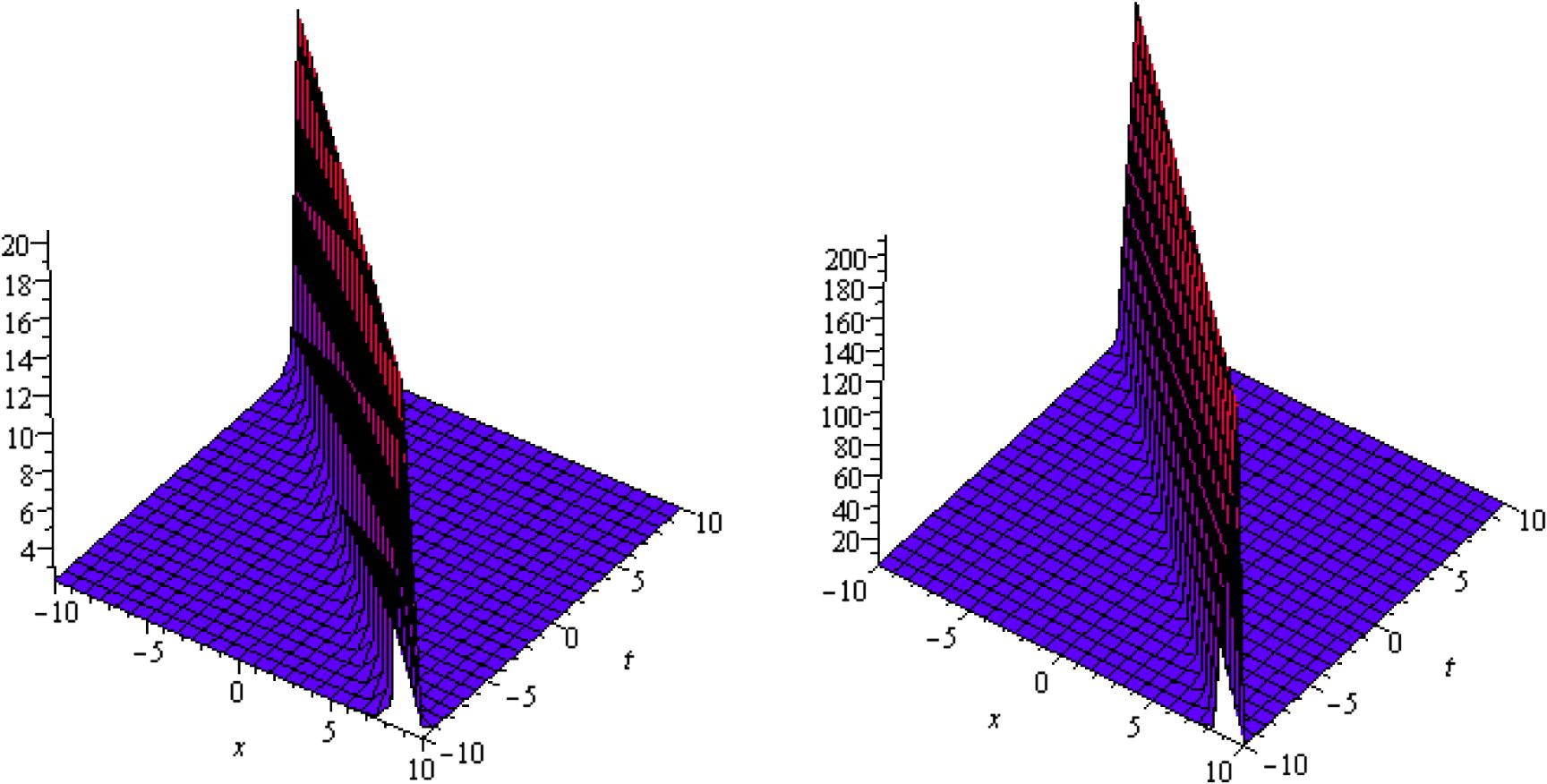
3D plot of soliton solution of u1 and v1 with −10 ⩽ x,t ⩽ 10 respectively.
Solutions
of the coupled Higgs equation and
of the Maccari system with y = 0 represent the exact periodic traveling wave solutions. Periodic solutions are traveling wave solutions that are periodic, such as cos (x − t). Fig. 2 below shows the periodic solution of
and
for r = 1, c = 1,
, μ = 3, A0 = 1, A1 = 2 and E = 0.5 with
respectively. The other figures are ignored for convenience.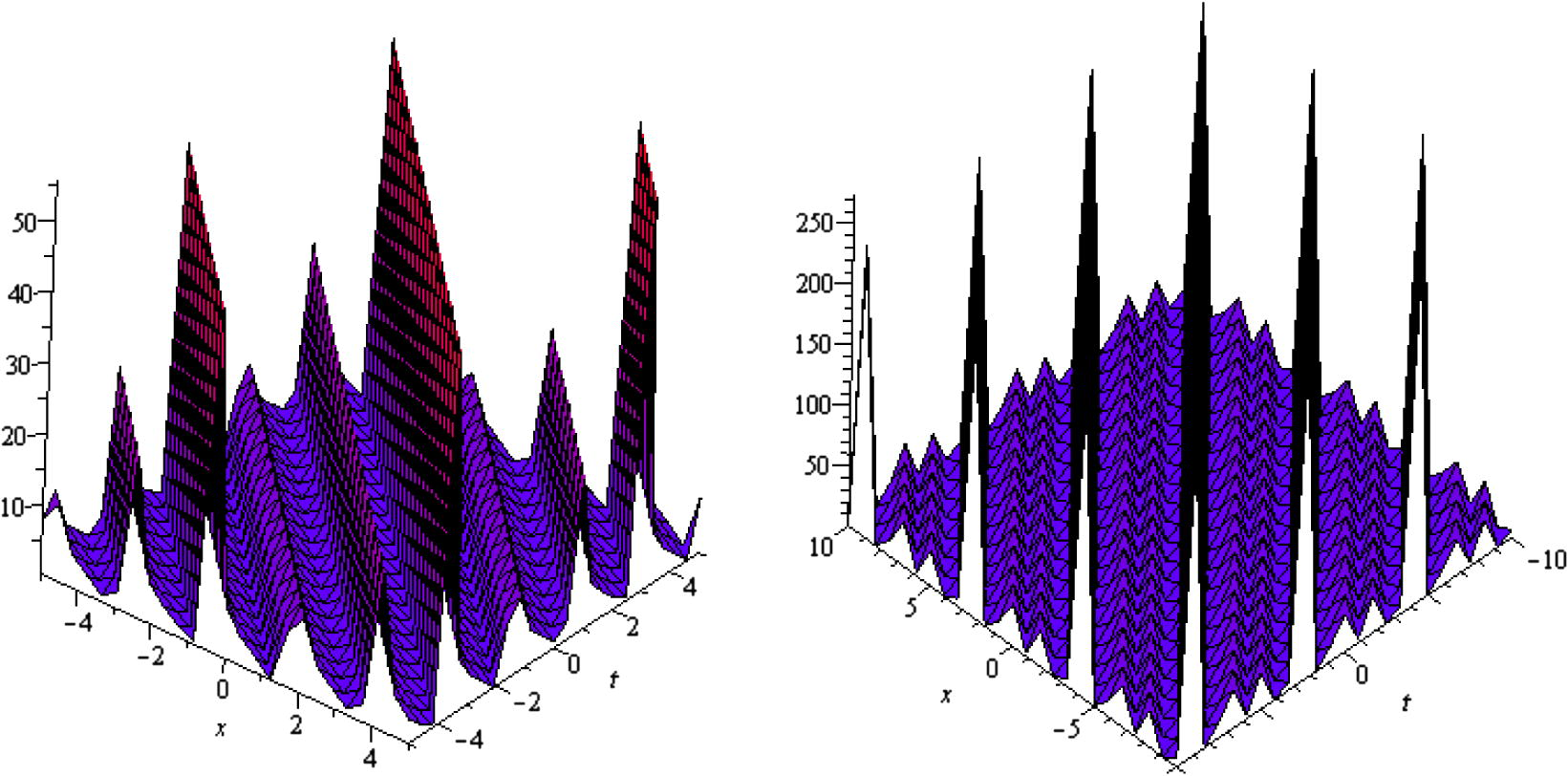
3D plot of the periodic traveling wave solution of u3 and v3 with −10 ⩽ x,t ⩽ 10 respectively.
Solutions
and v10 of the coupled Higgs equation (11) represent the singular kink-type traveling wave solutions. Fig. 3 shows the shape of the exact singular kink-type solution of
and
for r = 1, c = 1,
, μ = 0, A0 = 1, A1 = 2 and E = 0.5 with
respectively. We note that kink solution acquires non-vanishing values as x → ∞. For convenience the other figures are omitted.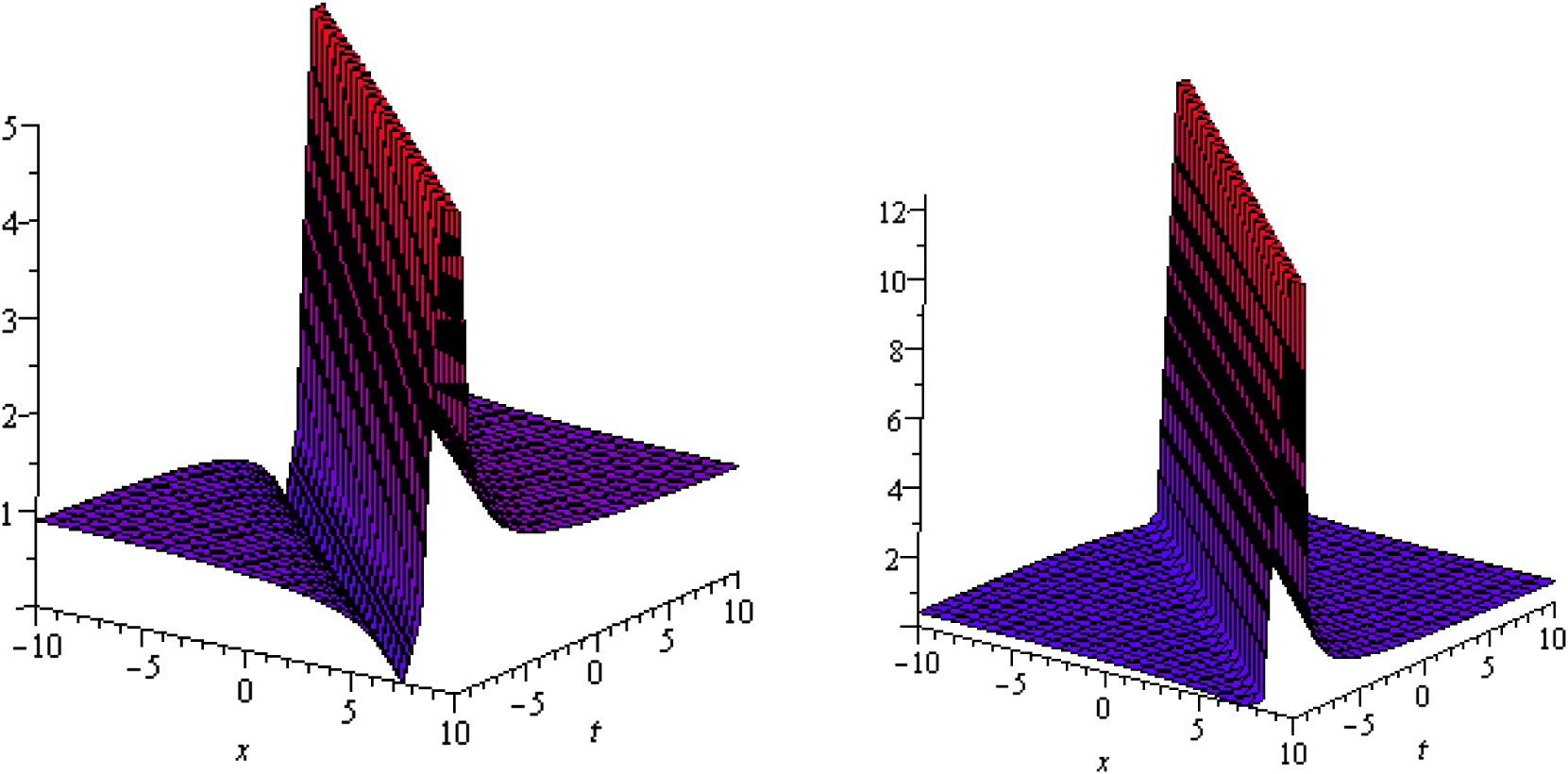
3D plot of the singular Kink traveling wave solution of u9 and v9 with −10 ⩽ x,t ⩽ 10 respectively.
Solutions v15 of the coupled Higgs Eq. (11) and
of the Maccari system (35) for y = 0 are presented cuspon. Cuspons are another form of solitons where solution exhibits cusps at their crests. Fig. 4 below shows the cuspon of u20 for p = 1, q = 2,
, μ = 0, A1 = 2 and E = 0.5 with
.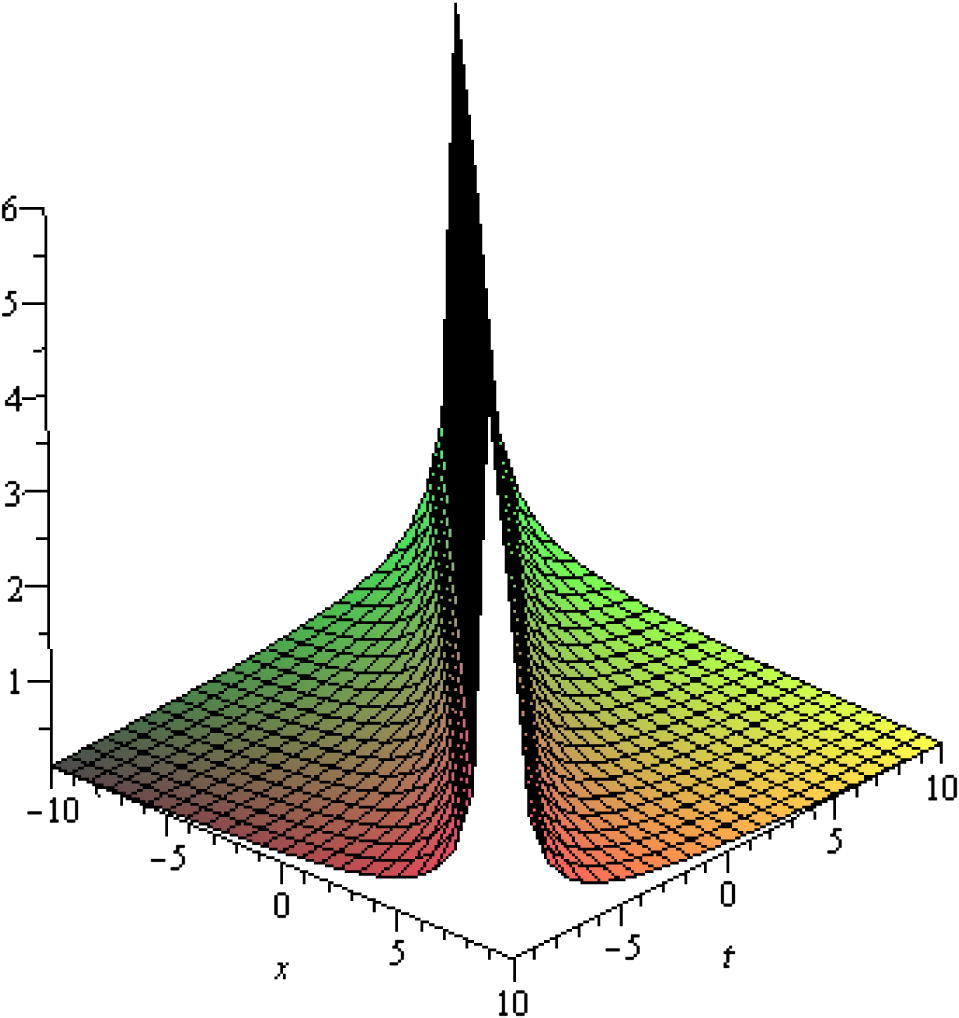
3D plot of cuspon solution of u20 with −10 ⩽ x,t ⩽ 10, y = 0.
Fig. 5 below shows the singular cuspon of the coupled Higgs equation, obtained from solution v8 for c = - 1,
, μ = 2, A0 = 1, A1 = 2 and E = 0.5 with
.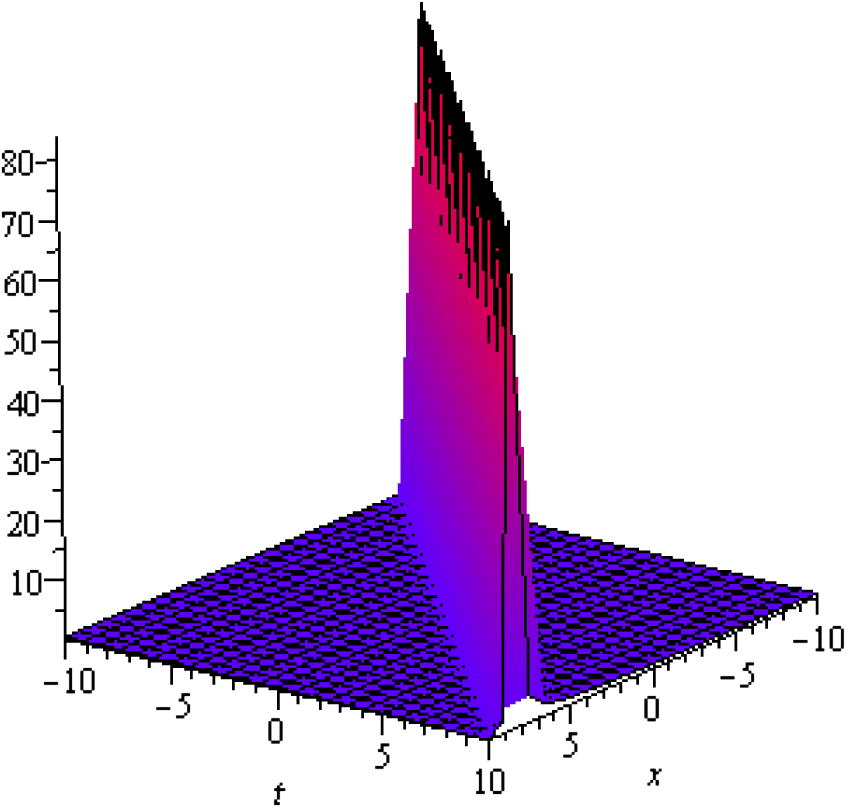
3D plot of singular cuspon solution of v8 with −10 ⩽ x,t ⩽ 10.
Finally, solutions u12, u13, u14 and u15 of the coupled Higgs equation (11) represent the solitary wave solutions. Fig. 6 shows the shape of the exact solitary wave solutions of
for r = 1, c = 1,
, μ = 3 and E = 0.5 with
.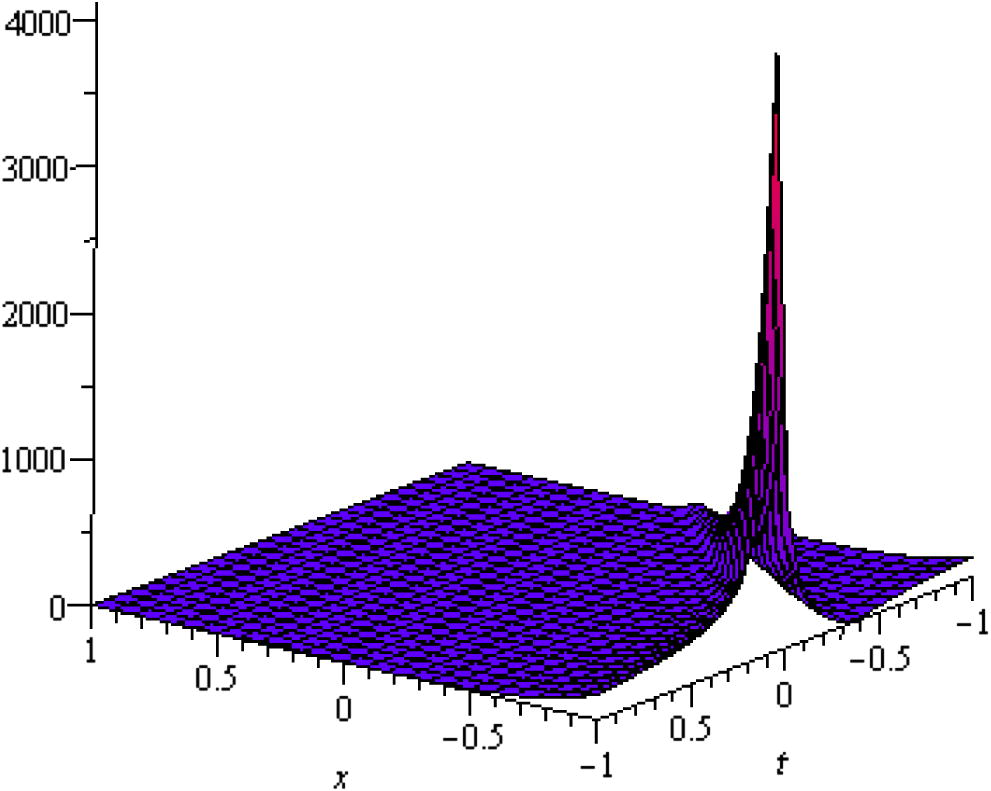
3D plot of solitary wave solution of u12 with −10 ⩽ x,t ⩽ 10.
5 Comparisons
Many authors applied different methods to the coupled Higgs equation and the Maccari system for obtaining traveling wave solutions, for instance, Lee and Sakthivel (Lee and Sakthivel, 2013) used the Kudryashov method for finding traveling wave solutions to the coupled Higgs equation and the Maccari system. The obtaining solutions v5(x, t), v6(x, t), u13(x, t), v13(x, t) in this article are equivalent to the solutions v1(x, t), v2(x, t), u3(x, t), v3(x, t) found in Lee and Sakthivel (2013) for the Higgs field equations. The solutions u16(x, y, t), v13(x, y, t) found in Lee and Sakthivel (2013) are equivalent to our obtained solutions u16(x, y, t), v16(x, y, t) for the Maccari system. If we set k2 = 0, n = 1 and qyy = 0, then the generalized Maccari system (see Ref. Ahmed et al., 2013) can be reduced to the Maccari system (35). Ahmed et al. (2013) applied the mapping method and Lie symmetry analysis to obtain solitons and other solutions of the generalized Maccari system. They studied the solitons by combining the linear and power low nonlinearity effects. In this article, our obtained solutions v16, u18, v18, v19 also represent solitary wave solutions and solitons are originated according to the variation of the physical parameters. Therefore, if we take the particular values of the physical parameters, some of our obtained solutions coincide with some of the particular solutions obtained by other methods mentioned in the references (Lee and Sakthivel, 2013; Bahrami et al., 2011; Manafian and Zamanpour, 2013a,b). By means of this scheme, we found some new traveling wave solutions of the above mentioned equations. Therefore, the exp(−φ(ξ))-expansion method provides some new exact solutions which are not found in other literature. This is the main advantage of this method. The graphical representation describes the behaviors of the oscillatory particle in the Higgs field or any field which satisfies the coupled Higgs equation and the Maccari system. The solutions obtained in this article have been checked by putting them back into the original equation and found correct.
6 Conclusions
In this article, we considered two complex coupled equations and the exp(−Φ(ξ))-expansion method has been successfully implemented to obtain new generalized traveling wave solutions of the coupled Higgs equation and the Maccari system. The obtained solutions are expressed by the hyperbolic functions, trigonometric functions and rational functions. These types of solutions have many potential applications in nonlinear optics, fluid mechanics, quantum field theory, complex scalar nucleon field, and plasma physics. It is important to point out that the exp(−Φ(ξ))−expansion method is direct, concise, elementary and comparing to other methods, like the tanh-coth method, Jacobi elliptic function method, Exp-function method it is easier and effective for obtaining exact solutions for a wide class of coupled nonlinear problems. We have applied this method only in two coupled nonlinear equations, but it can be further applied to other coupled equations to establish new reliable solutions. The graphical representations explicitly reveal the high applicability and competence of the proposed algorithm.
References
- The extended tanh-method and its applications for solving nonlinear physical models. Appl. Math. Comput.. 2007;190:988-996.
- [Google Scholar]
- Modified extended tanh-function method and its application on nonlinear physical equations. Phys. Lett. A. 2006;353(6):487-492.
- [Google Scholar]
- Solitons, Nonlinear Evolution Equations and Inverse Scattering Transform. Cambridge: Cambridge Univ. Press; 1991.
- Solitons and other solutions to the generalized Maccari system. Romanian Reports Phys.. 2013;65(4):1138-1154.
- [Google Scholar]
- Exp-function for Duffing equation and new solutions of (2+1)-dimensional dispersive long wave equations. Prog. Appl. Math.. 2011;1(2):30-42.
- [Google Scholar]
- New Solitary and periodic solutions of nonlinear evolution equation by exp-function method. World Appl. Sci. J.. 2012;17(12):1603-1610.
- [Google Scholar]
- Solitary wave solutions of the fourth order Boussinesq equation through the exp(−Φ(η))-expansion method. SpringerPlus. 2014;3–344
- [CrossRef] [Google Scholar]
- Exact travelling wave solutions for some nonlinear physical models by (G′/G)-expansion method. Pramana-J. Phys.. 2011;77:263-275.
- [Google Scholar]
- Mathematical analysis of the generalized Benjamin and Burger-KdV equations via the extended trial equation method. J. Assoc. Arab Uni. Basic Appl. Sci. 2013 (in press). http://dx.doi.org/10.1016/j.jaubas.2013.07.005
- [Google Scholar]
- Extended Jacobi elliptic function rational expansion method and abundant families of Jacobi elliptic functions solutions to (1+1)-dimensional dispersive long wave equation. Chaos, Solitons Fractals. 2005;24:745-757.
- [Google Scholar]
- Homotopy perturbation technique for solving two point boundary value problems-comparison with other methods. Comput. Phys. Commun.. 2010;181:1021-1024.
- [Google Scholar]
- Some exact solutions of the (2+1)-dimensional breaking soliton equation using the three-wave method. World Acad. Sci. Engr. Technol.. 2012;87:31-34.
- [Google Scholar]
- Some complexiton type solutions of the (3+1)-dimensional Jimbo-Miwa equation. World Acad. Sci. Eng. Technol.. 2012;87:42-44.
- [Google Scholar]
- New exact travelling wave solutions using modified extended tanh-function method. Chaos, Solitons Fractals. 2007;31(4):840-852.
- [Google Scholar]
- He, J.H., Wu, X.H., 2006. Exp-function method for nonlinear wave equations, Chaos, Solitons Fractals 30(3), pp. 700–708 (1982).
- Exact solution of the KdV equation for multiple collisions of solutions. Phys. Rev. Lett.. 1971;27:1192-1194.
- [Google Scholar]
- New exact traveling wave solutions of some nonlinear higher-dimensional physical models. Reports Math. Phys.. 2012;70:39-50.
- [Google Scholar]
- Exact Travelling wave solutions of two important nonlinear partial differential equations. Z. Naturforsch., A. 2014;69a:155-162.
- [Google Scholar]
- Exact solutions of the generalized Kuramoto-Sivashinsky equation. Phys. Lett. A. 1990;147:287-291.
- [Google Scholar]
- On types of nonlinear non-integrable equations with exact solutions. Phys. Lett. A. 1991;155:269-275.
- [Google Scholar]
- Exact travelling wave solutions for some important nonlinear physical models, Pramana. J. Phys.. 2013;80:757-769.
- [Google Scholar]
- A new branch of solutions of boundary-layer flows over an impermeable stretched plate. Int. J. Heat Mass Transfer.. 2005;48:2529-2539.
- [Google Scholar]
- A general approach to get series solution of non-similarity boundary-layer flows. Commun. Nonlinear Sci. Numer. Simul.. 2009;14(5):2144-2159.
- [Google Scholar]
- Jacobi elliptic function expansion method and periodic wave solutions of nonlinear wave equations. Phys. Lett. A. 2001;289:69-74.
- [Google Scholar]
- A second Wronskian formulation of the Boussinesq equation. Nonlin. Anal. Theory Meth. Appl.. 2008;70(12):4245-4258.
- [Google Scholar]
- The tanh method: a tool for solving certain classes of nonlinear evolution and wave equations. J. Comput. Appl. Math.. 2004;164:529-541.
- [Google Scholar]
- Analytical treatment of the coupled Higgs equation and Maccari system via exp-function method. Acta Univ. Apulensis. 2013;33:203-216.
- [Google Scholar]
- Modification of Truncated expansion method to some complex nonlinear partial differential equations. Acta Univ. Apulensis. 2013;33:109-216.
- [Google Scholar]
- Mohyud-Din, S.T., Noor, M.A., Noor, K.I., 2009. Some relatively new techniques for nonlinear problems, Math. Prob. Eng. 2009 (Article ID 234849, 25 pages, doi:10.1155/2009/234849).
- Exp-function method for generalized travelling solutions of Calogero-Degasperis-Fokas equation. Z. Z. Naturforsch., A: Phys. Sci.. 2010;65a:78-84.
- [Google Scholar]
- Numerical soliton solution of the Kaup-Kupershmidt equation. Int. J. Numer. Methods Heat Fluid Flow Emerald. 2011;21(3):272-281.
- [Google Scholar]
- Analytical solution of wave system in with coupling controllers. Int. J. Numer. Methods Heat Fluid Flow, Emerald. 2011;21(2):198-205.
- [Google Scholar]
- Exp-function method for solving Kuramoto-Sivashinsky and Boussinesq equations. J. Appl. Math. Comput.. 2008;29:1-13.
- [CrossRef] [Google Scholar]
- Exp-function method for travelling wave solutions of nonlinear evolution equations. Appl. Math. Comput.. 2010;216:477-483.
- [Google Scholar]
- Traveling wave solutions of the (1+1)-dimensional compound KdVB equation by exp(−Φ(η))-expansion method. Int. J. Sci. Eng. Technol.. 2014;3(2):93-97.
- [Google Scholar]
- New travelling wave solutions of Burgers equation with finite transport memory. Z. Naturforsch. A (J. Phys. Sci.). 2010;65:633-640.
- [Google Scholar]
- Some new exact traveling wave solutions to the (3+1)-dimensional Zakharov-Kuznetsov equation and the Burgers equations via exp(−Φ(η))−expansion method. Front. Math. Appl.. 2014;1(1):1-8.
- [CrossRef] [Google Scholar]
- Single and multi-solitary wave solutions to a class of nonlinear evolution equations. J. Math. Anal. Appl.. 2008;343:273-298.
- [Google Scholar]
- Further improved F-expansion method and new exact solutions of Konopelchenko-Dubrovsky equation. Chaos, Solitons Fractals. 2005;25:601-610.
- [Google Scholar]
- Integrable properties of the general coupled nonlinear Schrödinger equations. J. Math. Phys.. 2010;51:023510.
- [Google Scholar]
- Quantized quasi-two-dimensional Bose-Einstein condensates with spatially modulated nonlinearity. Phys. Rev. A. 2010;81:025604.
- [Google Scholar]
- Exact vortex solitons in a quasi-two-dimensional Bose-Einstein condensate with spatially inhomogeneous cubic-quintic nonlinearity. Phys. Lett. A. 2012;376:3067-3070.
- [Google Scholar]
- The extended tanh-method for new compact and non-compact solutions for the KP-BBM and the ZK-BBM equations. Chaos, Solitons Fractals. 2008;38:1505-1516.
- [Google Scholar]
- Partial Differential equations and Solitary wave theory. Nonlin. Phys. Sci. 2009
- [CrossRef] [Google Scholar]
- Generalized method and its application in the higher-order nonlinear Schrodinger equation in nonlinear optical fibres. Chaos, Solitons Fractals. 2003;16:759-766.
- [Google Scholar]
- The repeated homogeneous balance method and its applications to nonlinear partial differential equations. Chaos, Solitons Fractals. 2006;28(2):448-453.
- [Google Scholar]
- Comment on the extended applications of homogeneous balance method. Appl. Math. Comput.. 2004;158(2):593-596.
- [Google Scholar]







